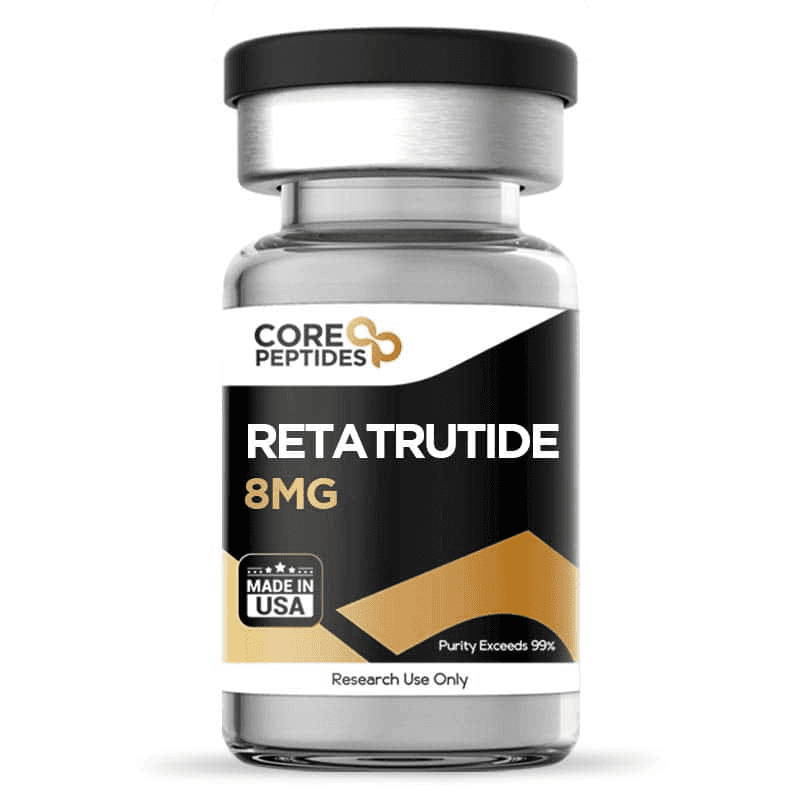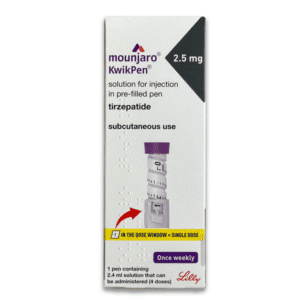Description
Retatrutide: The Next Generation Triple-Agonist Therapy for Weight Loss (Phase 3)
Retatrutide is an investigational, first-in-class triple-agonist therapy currently in Phase 3 clinical trials. Developed by Eli Lilly, this cutting-edge injectable medication targets three metabolic hormone receptors—GLP-1 (glucagon-like peptide-1), GIP (glucose-dependent insulinotropic polypeptide), and glucagon—to deliver unprecedented effects on weight loss, glucose control, and energy metabolism.
Mechanism of Action: Triple Hormone Synergy
Retatrutide represents a major leap beyond existing GLP-1 and GIP dual agonists like Tirzepatide. Its three-hormone activation approach is designed to deliver enhanced metabolic outcomes through:
-
GLP-1 activation – suppresses appetite, slows gastric emptying, and improves glucose regulation
-
GIP activation – boosts insulin sensitivity and promotes efficient fat metabolism
-
Glucagon receptor activation – increases resting energy expenditure and supports fat burning
Together, these actions help the body burn more fat while preserving lean muscle, providing a balanced and sustained weight loss effect.
Clinical Trial Data (SURMOUNT Phase 2 Results)
In the SURMOUNT-Phase 2 trial, Retatrutide demonstrated remarkable results compared to Tirzepatide (Mounjaro):
| Parameter | Retatrutide 10 mg (24 weeks) | Tirzepatide 10 mg (Comparator) |
|---|---|---|
| Average Weight Loss | 18.2% total body weight | 14.9% |
| A1c Reduction | 1.8% | 1.5% |
| Waist Circumference | -6.2 inches | -5.1 inches |
| Nausea Incidence | 32% | 28% |
These findings suggest that Retatrutide may deliver 3–5% greater total weight loss and improved metabolic efficiency over currently approved GLP-1/GIP dual agonists.
Proposed Dosing & Administration
Administration:
-
Form: Weekly subcutaneous injection (prefilled pen)
-
Sites: Abdomen or thigh (rotate injection sites)
-
Frequency: Once weekly, same day each week
Titration Schedule:
-
Weeks 1–4: 2 mg
-
Weeks 5–8: 4 mg
-
Weeks 9–12: 6 mg
-
Weeks 13–16: 8 mg
-
Week 17+: 10 mg maintenance
A monthly maintenance dose is currently under evaluation for future convenience.
Potential Advantages Over Current Therapies
Retatrutide shows several key benefits compared to existing agents like Tirzepatide and Semaglutide:
-
Greater Fat Loss: Up to 62% fat reduction (vs. 58% with Tirzepatide)
-
Improved Liver Health: 22% higher reduction in liver fat content
-
Increased Metabolic Rate: 15% boost in resting metabolic rate (RMR)
-
Preserved Muscle Mass: Balanced fat loss with minimal muscle depletion
These combined effects position Retatrutide as a potential game-changer for obesity and metabolic disease treatment.
Safety & Tolerability
Interim safety data from clinical trials show Retatrutide is well-tolerated, with side effects similar to other incretin-based therapies.
| Adverse Event | Incidence (10 mg) | Management |
|---|---|---|
| Nausea | 32% | Slow dose escalation, antiemetics |
| Diarrhea | 24% | Hydration, loperamide |
| Increased Heart Rate | +5–8 bpm | Monitor cardiovascular status |
| Injection Site Reactions | 9% | Rotate sites, apply topical steroids |
⚠️ Warning: As with other GLP-1 receptor agonists, preclinical studies suggest a possible risk of thyroid C-cell tumors. Retatrutide should not be used in individuals with a history of medullary thyroid carcinoma (MTC) or MEN-2 syndrome.
Ideal Patient Profile
Best suited for:
-
Individuals with BMI ≥35 and comorbidities
-
Non-responders to GLP-1 or GLP-1/GIP dual agonists
-
Patients requiring >15% total body weight reduction
Contraindicated for:
-
History of thyroid cancer or MEN type 2
-
Severe renal or hepatic impairment
Monitoring Guidelines
To ensure safety and optimal results, patients may require the following evaluations:
Baseline:
-
Calcitonin level
-
Thyroid ultrasound
-
Pancreatic enzyme assessment
-
Cardiac evaluation
Ongoing:
-
Monthly weight and BMI tracking
-
Quarterly metabolic blood panels
-
Annual DEXA scans for body composition
Projected Pricing & Access
Pending FDA and MHRA approval, Retatrutide is expected to be priced between $1,200–$1,500 per month.
Likely approved indications will include:
-
Obesity (BMI ≥30)
-
Overweight with comorbidities (BMI ≥27)
-
NASH with fibrosis
-
Treatment-resistant Type 2 Diabetes
Access may require documentation of prior medication trials and lifestyle interventions.



Reviews
There are no reviews yet.